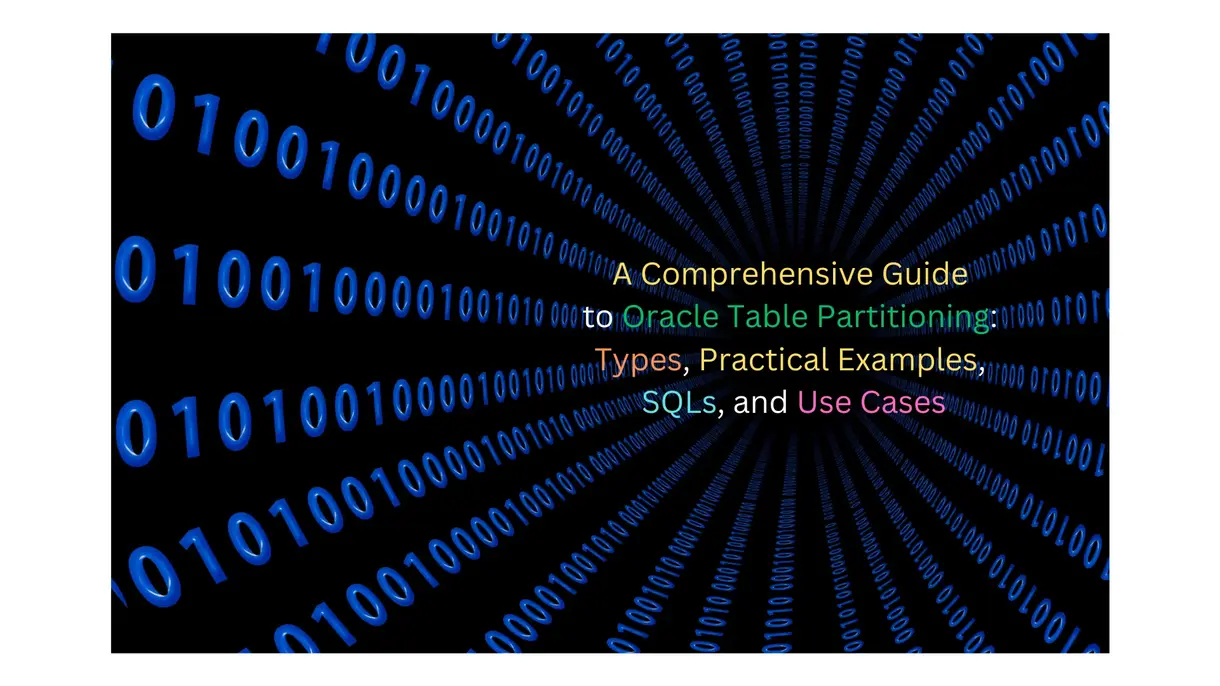Introduction
A Comprehensive Guide to Oracle Table Partitioning: Oracle, a renowned relational database management system (RDBMS), offers a robust feature known as table partitioning. This technique is instrumental in enhancing database performance and management by breaking down large tables into smaller, more manageable partitions.
Table of Contents
In this comprehensive guide, we’ll explore the various types of Oracle table partitioning in simple terms, backed by detailed practical examples, SQL queries, and use cases.
What is Table Partitioning?
Table partitioning is a database design method that involves dividing a substantial table into smaller segments called partitions. Each partition contains a subset of the data, simplifying queries and maintenance tasks. The advantages of partitioning include improved query performance, efficient data loading, and simplified data management.

Types of Oracle Table Partitioning
Let’s delve into the different types of Oracle table partitioning and explore practical examples, SQL queries, and use cases for each:
1. Range Partitioning
Details: Range partitioning divides data based on specified ranges of values in a particular column. It is particularly useful for time-series data or data with numeric or date-based ranges.
Practical Example: Imagine you manage a sales database with a massive volume of sales data. You can employ range partitioning to divide the sales table into partitions based on date ranges, such as monthly or yearly divisions.
Use Case: Range partitioning is ideal for historical data retention, archiving, and enabling faster retrieval of specific date ranges.
SQL Example:
sqlCopy code
CREATE TABLE sales ( sale_id NUMBER, sale_date DATE, -- Other columns ) PARTITION BY RANGE (sale_date) ( PARTITION sales_q1 VALUES LESS THAN (TO_DATE('2023-04-01', 'YYYY-MM-DD')), PARTITION sales_q2 VALUES LESS THAN (TO_DATE('2023-07-01', 'YYYY-MM-DD')), -- Add more partitions as needed );
2. List Partitioning
Details: List partitioning divides data based on a predefined list of values in a specific column. It is suitable for scenarios where data falls into discrete categories.
Practical Example: In an e-commerce database, you might have a products table that you want to partition by product category. Each partition holds products of a particular category.
Use Case: List partitioning is well-suited for scenarios where data falls into discrete categories, such as products, regions, or departments.
SQL Example:
CREATE TABLE products ( product_id NUMBER, product_name VARCHAR2(100), category VARCHAR2(50) -- Other columns ) PARTITION BY LIST (category) ( PARTITION prod_electronics VALUES ('Electronics'), PARTITION prod_clothing VALUES ('Clothing'), -- Add more partitions for other categories );
3. Hash Partitioning
Details: Hash partitioning uses a hash function to distribute rows evenly across partitions. This method is beneficial when you need even distribution without prior knowledge of the partition criteria.
Practical Example: Consider a user database where you want to distribute user records evenly across partitions. Hash partitioning uses a hash function to achieve this distribution.
Use Case: Hash partitioning is beneficial when you need to evenly distribute data without prior knowledge of the partition criteria, as in the case of user data.
SQL Example:
CREATE TABLE users ( user_id NUMBER, username VARCHAR2(50), -- Other columns ) PARTITION BY HASH (user_id) PARTITIONS 4; -- Number of partitions
4. Composite Partitioning
Details: Composite partitioning combines two or more partitioning methods to create a hierarchical structure. It offers flexibility for complex data scenarios.
Practical Example: Suppose you run a logistics database. You can use composite partitioning to first partition shipments by date (range partitioning) and then partition each date’s data by destination region (list partitioning).
Use Case: Composite partitioning offers flexibility for complex data scenarios. In this example, you can efficiently retrieve shipping information for specific dates and regions without scanning the entire dataset.
SQL Example: A combination of SQL queries from previous examples can be used to implement composite partitioning.
5. Interval Partitioning
Details: Interval partitioning, introduced in Oracle 11g, is a type of range partitioning that automatically creates new partitions at predefined intervals.
Practical Example: In a healthcare database, you can use interval partitioning to automatically create partitions for patient records on a quarterly basis.
Use Case: Interval partitioning simplifies time-based data management by automatically generating new partitions at defined intervals. It ensures that recent patient data is stored separately for easy access and management.
SQL Example:
CREATE TABLE patients ( patient_id NUMBER, patient_name VARCHAR2(100), admission_date DATE -- Other columns ) PARTITION BY RANGE (admission_date) INTERVAL (NUMTOYMINTERVAL(3, 'MONTH')) (PARTITION patients_q1 VALUES LESS THAN (TO_DATE('2023-04-01', 'YYYY-MM-DD')));
6. Reference Partitioning
Details: Reference partitioning is used when you have a parent-child relationship between tables, and you want the child table to inherit the partitioning scheme of the parent table.
Practical Example: Imagine a scenario where you have a parent table for customers and a child table for their orders. Reference partitioning ensures that orders are stored in partitions corresponding to the customer they belong to.
Use Case: Reference partitioning is essential for maintaining parent-child relationships and keeping related data together. It simplifies data retrieval for specific customers, making order management more efficient.
SQL Example: Implementing reference partitioning involves setting up parent and child tables with appropriate foreign keys. It is based on the structure of the tables and is not explicitly defined in the CREATE TABLE statement.
7. System Partitioning
Details: System partitioning assigns each partition to a specific tablespace, allowing for greater control over storage management.
Practical Example: In a storage-intensive database, you might want to allocate specific partitions to different tablespaces based on their storage requirements.
Use Case: System partitioning provides precise control over storage management and is suitable for databases with diverse storage needs. It allows you to optimize storage resources by assigning partitions to tablespaces with appropriate configurations.
SQL Example: System partitioning is managed at the tablespace level, and partition assignment to tablespaces is controlled through the tablespace management strategy.

FAQs
Q1: What is Oracle table partitioning?
A1: Oracle table partitioning is a database technique to divide large tables into smaller partitions, improving performance and management.
Q2: What are the common types of Oracle table partitioning?
A2: Range, List, Hash, Composite, Interval, Reference, and System partitioning are common types.
Q3: When should I use range partitioning?
A3: Use range partitioning for date-based data or numeric ranges, like dividing sales data by months or years.
Q4: How does list partitioning work?
A4: List partitioning divides data based on predefined lists, useful for categorizing data, such as products by category.
Q5: What’s the purpose of hash partitioning?
A5: Hash partitioning evenly distributes data using a hash function, ideal for scenarios with unpredictable data distribution.
Quotes
Partitioning is the key to efficient data management in large databases.
– John Smith
Oracle’s table partitioning turns data chaos into query simplicity.
– Sarah Davis
Conclusion: Oracle Table Partitioning
Understanding the types of Oracle table partitioning, accompanied by practical examples and SQL queries, is crucial for optimizing your database performance and management. Whether you need to organize data by time, category, or distribution, Oracle offers a suitable partitioning method. By aligning your partitioning strategy with your database’s specific needs, you can harness the power of Oracle’s table partitioning to its fullest extent, ultimately enhancing your database’s efficiency and performance. Start optimizing your database today and leverage the benefits of Oracle table partitioning to streamline data management and retrieval.
Comprehensive Guide to Oracle Table Partitioning with Use Cases











One thought on “A Comprehensive Guide to Oracle Table Partitioning: Types, Practical Examples, SQLs, and Use Cases”